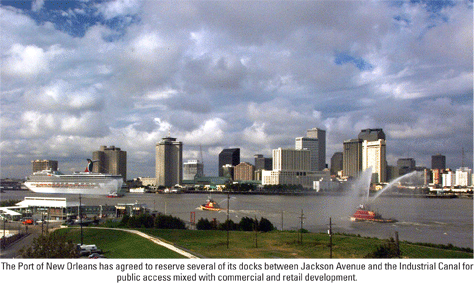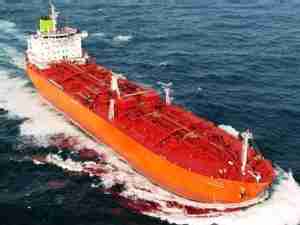In a historic move aimed at creating new public spaces and commercial development along the New Orleans riverfront, the Board of Commissioners of the Port of New Orleans approved a proposed Riverfront Development Agreement with the City of New Orleans. The agreement must now be approved by the city to go into effect.
 The Port has agreed to reserve several of its docks between Jackson Avenue and the Industrial Canal for public access mixed with commercial and retail development. Potential projects include parks, hotels, a riverfront amphitheater, shops and other developments.The Port's cruise and cargo operations will continue in the area as well. The docks where commercial development will be permitted are not suitable for the large scale cargo terminals like the ones that the Port has between Jackson Avenue and Audubon Park.
The Port has agreed to reserve several of its docks between Jackson Avenue and the Industrial Canal for public access mixed with commercial and retail development. Potential projects include parks, hotels, a riverfront amphitheater, shops and other developments.The Port's cruise and cargo operations will continue in the area as well. The docks where commercial development will be permitted are not suitable for the large scale cargo terminals like the ones that the Port has between Jackson Avenue and Audubon Park.
'The Port of New Orleans exists to create new economic opportunities for the New Orleans region. The Mississippi River is world-renowned as an avenue of commerce, but the riverfront also provides majestic vistas that are a testament to the beauty and history of this city,' said Gary P. LaGrange, President and CEO of the Port of New Orleans.
'When I was appointed to run this Port four years ago, I thought that we were missing many opportunities to open up unused portions of the riverfront to the public. Today, we are sending out an invitation to developers to create new economic opportunities along the Mississippi River that are compatible with the historic character of our city,' LaGrange said.
The City and Port will jointly establish a Riverfront Committee for Non-Maritime Development. The proposed committee will be composed of four members, two appointed by the City and two appointed by the Port. The Committee will plan, review and approve all non-maritime riverfront development projects to assure coordination between maritime activities and new development.
All new projects must go through the existing New Orleans planning and approval process.
Wharves where non-maritime development would be permitted include Piety, Press, Louisa, Mandeville, Market and parts of Orange, Celeste and St. Andrew.
Wharves reserved for maritime purposes include Poland, Pauline, Congress, Desire, the front apron of Mandeville, Esplanade, Governor Nicholls, Julia and Erato. Congress and Desire could be temporarily used for a park, but would be turned back to the Port when needed for maritime purposes.
Wharves that could be used for both maritime and non-maritime uses include the Mandeville Street Wharf and the Julia Street Wharf. Cargo handling will continue along the front apron of Mandeville, but the rest of the property will be available for redevelopment. The Port will continue to operate two cruise terminals at Julia Street but a hotel developer is interested in building a hotel that would co-exist with the cruise operations.
Governor Nicholls and Esplanade Wharves will remain as maritime cargo facilities unless and until their capacity is recreated at an alternate location acceptable to the Port at no cost to the Port.

The Port will retain its ability to berth ships even at docks that are used for non-maritime activity as long as the vessels are not berthed at those docks long term.
Over the last few decades, there have been a number of non-maritime projects developed along the Riverfront, such as the Hilton Hotel, the Riverwalk Mall, the Audubon Aquarium of the Americas and One River Place condominiums. Each of those projects was negotiated among the Port, the City and the developer on an individual basis. This new agreement sets the ground rules for how the Port and the City will interact on these projects and identifies a large portion of riverfront








